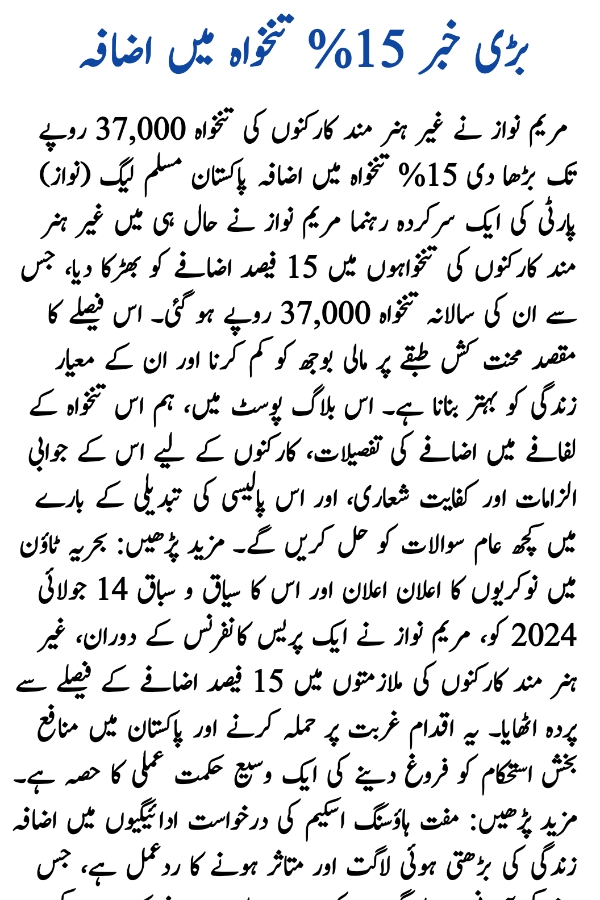15% Salary Increase
Maryam Nawaz, a prominent leader of the Pakistan Muslim League( Nawaz) party, lately blazed a 15% salary increase for unskilled workers, raising their yearly pay to 37,000 rupees. This decision aims to palliate the fiscal burdens on the working class and ameliorate their standard of living. In this blog post, we will explore the details of this pay envelope hike, its counteraccusations for workers and the frugality, and address some common questions about this policy change. Read More: Jobs Announcement in Bahria Town
The Announcement and Its Context
On July 14, 2024, Maryam Nawaz, during a press conference, unveiled the decision to increase the hires of unskilled workers by 15. This adaptation raises the minimal pay envelope from the former 32,174 rupees to 37,000 rupees per month. The move is part of a broader strategy to attack poverty and boost profitable stability in Pakistan. Read More: Free Housing Scheme Application
The payment hike is a response to the rising cost of living and affectation, which have oppressively affected low- income homes. By adding the minimum pay envelope, the government aims to ensure that workers can meet their introductory requirements, similar to food, housing, and healthcare, and ameliorate their overall quality of life.

Maryam Nawaz 15% Salary Increase: Economic Impact
Benefits for Workers
- The most immediate heirs of this payment increase are unskilled workers across colorful diligence. The fresh income can significantly ameliorate their fiscal situation, allowing them to get better living conditions and access to essential services. This, in turn, can lead to increased productivity and job satisfaction among workers.
Stimulating the Economy
- The payment increase is anticipated to have a positive ripple effect on the frugality. With further disposable income, workers are likely to spend further on goods and services, thereby boosting demand and stimulating profitable growth. This increase in consumer spending can help businesses expand, produce further jobs, and contribute to a healthier frugality. Read More: Benazir Income Support Program Online Registration 8171
Addressing Income Inequality
- Raising the minimum pay envelope is also a step towards reducing income inequality in Pakistan. By icing that unskilled workers admit fair compensation for their labor, the government aims to bridge the gap between different income groups and promote social equity.
Challenges and Considerations
- While the payment increase brings several benefits, it also presents certain challenges and considerations that need to be addressed
Inflationary Pressures
- One eventuality challenge is the threat of inflationary pressures. As stipend rises, businesses may pass on the increased labor costs to consumers in the form of advanced prices for goods and services. This could potentially neutralize some of the benefits of the payment increase for workers. Read More: How to Check PMT Score Online For Benazir Kafalat Program With Mobile
Impact on Small Businesses
- Small businesses, in particular, may find it grueling to absorb the fresh labor costs. The government may need to give support and impulses to help these businesses acclimate to the new pay envelope structure without compromising their viability.
Table: Comparative Analysis
The table below provides a comparative analysis of the minimum wage increase:
| Parameter | Previous Minimum Wage | New Minimum Wage | Percentage Increase |
| Monthly Salary (Rupees) | 32,174 | 37,000 | 15% |
| Annual Salary (Rupees) | 386,088 | 444,000 | 15% |
| Additional Monthly Income (Rupees) | N/A | 4,826 | N/A |
| Additional Annual Income (Rupees) | N/A | 57,912 | N/A |
Final Thought
The 15% salary increase for unskilled workers blazoned by Maryam Nawaz is a significant step towards perfecting the lives of low- income earners in Pakistan. By raising the minimum pay envelope to 37,000 rupees, the government aims to address the challenges posed by affectation and the rising cost of living. While there are implicit challenges, similar as inflationary pressures and the impact on small businesses, the overall benefits of this policy are anticipated to overweigh the downsides. Read More: BISP Check By CNIC
FAQs
- Who’ll profit from the payment increase?
- Unskilled workers across colorful diligence will profit from the 15% salary increase, raising their minimal pay envelope to 37,000 rupees per month.
- When will the payment increase take effect?
- The exact perpetration date has not been specified yet, but it’s anticipated to be executed soon following the advertisement.
- How will the payment increase affect small businesses?
- Small businesses may face challenges in absorbing the fresh labor costs. The government may need to give support and impulses to help these businesses acclimate to the new pay envelope structure.
- Will the payment increase lead to affectation?
- There’s an implicit threat of inflationary pressures as businesses might pass on the increased labor costs to consumers. Still, the government is likely to apply measures to alleviate this threat.
- How does the payment increase contribute to profitable growth?
- With further disposable income, workers are anticipated to spend further on goods and services, boosting demand and stimulating profitable growth. This increase in consumer spending can help businesses expand and produce further jobs.

